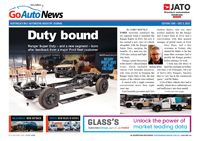Make / Model Search
Future models - Hyundai - Santa FeNew York show: Hyundai Santa Fe takes a bowComing soon: The new Santa Fe SUV will hit Australian Hyundai showrooms by year's end. Australia to get all-new Hyundai Santa Fe in late 2012, but not stretch version5 Apr 2012 AUSTRALIA is on a countdown to the all-new third-generation Santa Fe that was unveiled at the New York motor show overnight, but will miss out on the new long-wheelbase version that appeared on the Hyundai stand alongside the standard model. Hyundai Motor Company Australia (HMCA) has confirmed that the latest iteration of its largest SUV will debut in Australian showrooms later in 2012, but only in the standard wheel-base guise because the new stretched version will be sold only in left-hand drive markets such as North America. In the US, the long-wheelbase model will be the only variant available with seven seats, while the standard model – to be called Santa Fe Sport in that market – will be sold exclusively in five-seat format. It remains to be seen if that will jeopardise the availability of the popular three-row layout in Australia where the Santa Fe has been sold exclusively with seven seats since it was last upgraded in 2009. However, as the standard model retains the same overall dimensions – including the 2700mm wheelbase – as the current seven-seat model in Australia, it is likely to be business as usual for family buyers here. HMCA is keeping details of the powertrain line-up and specifications of the new model close to its chest until launch time, but it has confirmed that the vehicle will be called Santa Fe in Australia, not Santa Fe Sport as in America, and made in South Korea, not in Kia’s American factory like some US variants. Hyundai_Santa_Fe_stack.jpgContrary to some reports, the vehicle will be known as Santa Fe globally, and not by various names such as ix45 in some regions such as Europe. In North America, the Santa Fe will be available with three petrol engines: a naturally aspirated 142kW 2.4-litre Theta direct-injected four-cylinder petrol that is also available in models such as the i45 in Australia a turbocharged 197kW 2.0-litre four-cylinder and a 213kW Lambda II 3.3-litre direct-injected V6 in the flagship long-wheelbase model. For Australia, it is a no-brainer that HMCA will retain the well-regarded 2.2-litre CRDi turbo diesel that currently is sold alongside a 3.5-litre V6 and that will probably make way for the new 3.3-litre Lambda II version revealed in the new line-up in the US. The American models come in both front-wheel drive and all-wheel drive, depending on the powertrain, and all engines are fitted with a six-speed automatic transmission, in the US at least (the current Australian range offers both manual and auto with the diesel). As expected, the new Santa Fe is cloaked in all-new sheetmetal in a fresh interpretation of the South Korean company’s Fluidic Sculpture design language, called ‘Storm Edge’, that Hyundai says will be the future direction for other Hyundai SUVs. Evolutionary rather than revolutionary, the new Santa Fe gains a chrome-finished hexagonal grille and more pronounced sculpting down the flanks. The all-new architecture uses 30 per cent more high-strength steel to increase body rigidity by 16 per cent while also helping to slice the overall vehicle weight by up to 136kg. Hyundai claims the new 1751kg Santa Fe is even significantly lighter than the Audi Q5 that uses aluminium and magnesium to cut the kilos. The Santa Fe again sits on MacPherson strut suspension up front and a multi-link set-up at the rear, with alloy wheels ranging from 17 inch to 19 inch, depending on the model. In New York, Hyundai claimed the Santa Fe would become the first non-luxury SUV to have torque vectoring cornering control, which can distribute torque via a multi-plate clutch to any single wheel according to need while also braking any wheel individually for cornering stability and reduction of oversteer or understeer. New to Santa Fe is a three-mode steering system that allows the driver to select between comfort, normal and sport settings to vary the steering effort according to taste and conditions. This is made possible by the inclusion of electric-assisted power steering, which also aids fuel economy. The airbag count goes up from six to seven with the addition of a driver’s knee airbag, along with extras safety technology such as blind-spot warning system and a telematics system called Blue Link that, like GM’s pioneering OnStar system, can alert emergency services in the event of a crash. In Australia, Hyundai will be hoping the new Santa Fe can take the fight up to the likes of the top-selling Toyota duo – Kluger and Prado – and other large SUVs such as the Ford Territory, Holden Captiva 7 and Mitsubishi Pajero. This year, the Santa Fe has averaged 300 units a month, compared with more than 1000 units a month by the market leaders. The current model is sold in front-wheel drive with the petrol 3.5-litre V6 powertrain, and all-wheel drive with the diesel. Prices range from $36,990 (plus on-road costs) to $48,490.  Read moreAll future modelsSanta Fe pricing
Motor industry news |
Click to shareHyundai modelsResearch Hyundai All future modelsSanta Fe pricing
Motor industry news |



 Alfa Romeo
Alfa Romeo Abarth
Abarth Audi
Audi Aston Martin
Aston Martin BMW
BMW Bentley
Bentley Ferrari
Ferrari Chevrolet
Chevrolet Ford
Ford Fiat
Fiat GWM
GWM Foton
Foton Hyundai
Hyundai Honda
Honda Jaguar
Jaguar Isuzu
Isuzu Kia
Kia Jeep
Jeep Land Rover
Land Rover Lamborghini
Lamborghini Maserati
Maserati Lexus
Lexus McLaren
McLaren Mazda
Mazda Mercedes-Benz
Mercedes-Benz Mitsubishi
Mitsubishi Mini
Mini Peugeot
Peugeot Nissan
Nissan Ram
Ram Porsche
Porsche Rolls-Royce
Rolls-Royce Smart
Smart Skoda
Skoda Suzuki
Suzuki Subaru
Subaru Toyota
Toyota Tesla
Tesla Volvo
Volvo Zeekr
Zeekr







Facebook Twitter Instagram